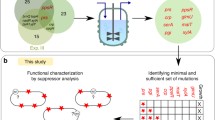Abstract
2-, 3-, and 4-chloroaniline degrading bacteria were obtained by natural genetic exchange between an aniline or toluidine degrading Pseudomonas strain and the chlorocatechol assimilating Pseudomonas sp. B13. Hybrid organisms were isolated through cocultivation of the parent strains in the chemostat as well as through conjugation on solid media in presence of chloroanilines as the selective substrates. Biochemical analysis of the gene products in the hybrid strains clearly showed that the genes coding for the aniline dioxygenase or the genes for the chlorocatechol assimilatory sequence had been transferred.
Similar content being viewed by others
References
Azouz WM, Parke DV, Williams RT (1955) Studies in detoxification 62. The metabolism of halobenzene, ortho- and paradichlorobenzenes. Biochem J 59:410–415
Bartha R (1971) Fate of herbicide-derived chloroanilines in soil. J Agric Food Chem 19:385–387
Bartha R (1980) Pesticide residues in humus. ASM News 46:356–360
Biltz H, Stepf K (1904) Über die Chlorierung des Salicylaldehyds. Ber Dtsch Chem Ges 37:4022–4031
Bradford MM (1976) A rapid and sensitive method for the quantitation of microgram quantities of protein utilizing the principles of protein dye-binding. Anal Biochem 72:248–254
Chisaka H, Kearney PC (1970) Metabolism of propanil in soils. J Agric Food Chem 18:854–858
Corke CT, Bunce NJ, Beaumont AL, Merrick RL (1979) Diazonium cations as intermediates in the microbial transformation of chloroanilines to chlorinated biphenyls, azo-compounds and triazenes. J Agric Food Chem 27:644–646
Deuel LE, Brown KW, Turner FC, Westfall DG, Price JP (1977) Persistence of propanil, DCA, and TCAB in soil and water under flooded rice culture. J Environ Anal 6:127
Dorn E, Knackmuss HJ (1978a) Chemical structure and biodegradability of halogenated aromatic compounds. Two catechol 1,2-dioxygenases from a 3-chlorobenzoate-grown pseudomonad. Biochem J 174:73–84
Dorn E, Knackmuss HJ (1978b) Chemical structure and biodegradability of halogenated aromatic compounds. Substituent effects on 1,2-dioxygenation of catechol. Biochem J 174:85–94
Dorn E, Hellwig M, Reineke W, Knackmuss HJ (1974) Isolation and characterization of a 3-chlorobenzoate degrading pseudomonad. Arch Microbiol 99:61–70
Evans WC, Smith BSW, Fernley HN, Davies JI (1971) Bacterial metabolism of 2,4-dichlorophenoxyacetate. Biochem J 122:543–551
Fisher PR, Appleton J, Pemberton JM (1978) Isolation and characterization of the pesticide-degrading plasmid pJP1 from Alcaligenes paradoxus. J Bacteriol 135:798–804
Hartmann J, Reineke W, Knackmuss HJ (1979) Metabolism of 3-chloro, 4-chloro-, and 3,5-dichlorobenzoate by a pseudomonad. Appl Environ Microbiol 37:421–428
Kaufman DD, Blake I (1973) Microbial degradation of several acetamide, acylanilide, carbamate, toluidine and urea pesticides. Soil Biol Biochem 5:297–308
Kilpi S, Backström V, Korhale M (1980) Degradation of 2-methyl-4-chlorophenoxyacetic acid (MCPA), 2,4-dichlorophenoxyacetic (2,4-D), benzoic acid and salicylic acid by Pseudomonas sp. HV 3. FEMS Microbiol Lett 8:177–182
Knackmuss HJ (1983) Xenobiotics degradation in industrial sewage: haloaromatics as target substrates. Biochem Soc Symp 48:173–190
Nozaki M (1970) Meta pyrocatechase (Pseudomonas). In: Tabor H, Tabor CW (eds) Methods in enzymology, vol 17 A. Academic Press, New York, pp 522–525
Ornston LN (1966) The conversion of catechol and protocatechuate to β-ketoadipate by Pseudomonas putida. III. Enzymes of the catechol pathway. J Biol Chem 241:3795–3799
Reber H, Helm V, Karanth NGK (1979) Comparative studies on the metabolism of aniline and chloroanilines by Pseudomonas multivorans, Strain An 1. Eur J Appl Microbiol Biotechnol 7:181–189
Reineke W, Knackmuss HJ (1979) Construction of haloaromatics utilising bacteria. Nature 277:385–386
Reineke W, Knackmuss HJ (1980) Hybrid pathway for chlorobenzoate metabolism in Pseudomonas sp. B13 derivatives. J Bacteriol 142:467–473
Reineke W, Jeenes DJ, Williams PA, Knackmuss HJ (1982a) TOL plasmid pWWO in constructed halobenzoate-degrading Pseudomonas strains: prevention of meta-pathway. J Bacteriol 150:195–201
Reineke W, Wessels SW, Rubio MA, Latorre J, Schwien U, Schmidt E, Schlömann M, Knackmuss HJ (1982b) Degradation of monochlorinated aromatics following transfer of genes encoding chlorocatechol catabolism. FEMS Microbiol Lett 14:291–294
Schmidt E, Knackmuss HJ (1980) Chemical structure and biodegradability of halogenated aromatic compounds. Conversion of chlorinated muconic acids into maleoylacetic acid. Biochem J 192:339–347
Schmidt E, Remberg G, Knackmuss HJ (1980) Chemical structure and biodegradability of halogenated aromatic compounds. Halogenated muconic acids as intermediates. Biochem J 192:331–337
Schreiber A, Hellwig M, Dorn E, Reineke W, Knackmuss HJ (1980) Critical reactions in fluorobenzoic acid degradation by Pseudomonas sp. B13. Appl Environ Microbiol 39:58–67
Schukat B, Janke D, Krebs D, Fritsche W (1983) Cometabolic degradation of 2- and 3-chloroaniline because of glucose metabolism by Rhodococcus sp. An 117. Curr Microbiol 9:81–86
Schwien U, Schmidt E (1982) Improved degradation of monochlorophenols by a constructed strain. Appl Environ Microbiol 44:33–39
Surovtseva EG, Vasileva GK, Volnova AI, Baskunov BP (1980) Destruction of monochloroanilines by the meta cleavage by Alcaligenes faecalis. Dokl Akad Nauk SSSR 254:226–230
Tiedje JM, Duxbury JM, Alexander M, Dawson JE (1969) 2,4-D metabolism: Pathway of degradation of chlorocatechols by Arthrobacter sp. J Agric Food Chem 17:1021–1026
Wacek A, Fiedler R (1949) Über die Oxydation des Brenzcatechins zu Muconsäure. Monatsh Chem 80:170–185
Williams PA, Murray K (1974) Metabolism of benzoate and the methylbenzoates by Pseudomonas putida (arvilla) mt-2: evidence for the existence of a TOL plasmid. J Bacteriol 120:416–423
You JS, Bartha R (1982) Metabolism of 3,4-dichloroaniline by Pseudomonas putida. J Agric Food Chem 30:274–277
Zeyer J, Kearney PC (1982) Microbial degradation of para-chloroaniline as sole carbon and nitrogen source. Pest Biochem Physiol 17:215–223
Author information
Authors and Affiliations
Rights and permissions
About this article
Cite this article
Latorre, J., Reineke, W. & Knackmuss, HJ. Microbial metabolism of chloroanilines: enhanced evolution by natural genetic exchange. Arch. Microbiol. 140, 159–165 (1984). https://doi.org/10.1007/BF00454919
Received:
Accepted:
Issue Date:
DOI: https://doi.org/10.1007/BF00454919




